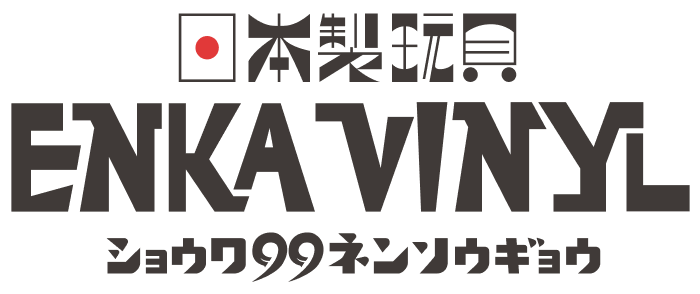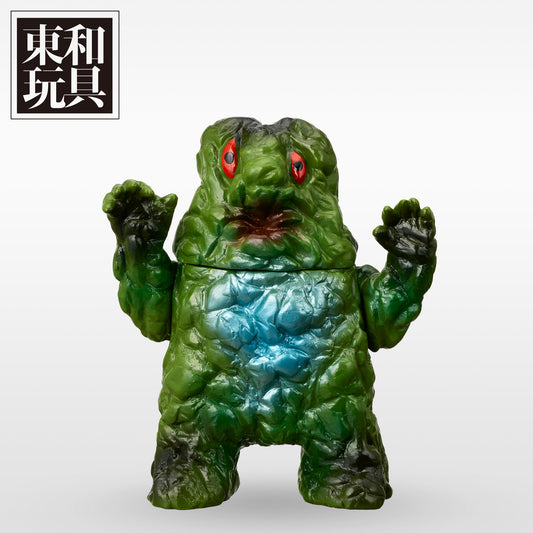Collabo Interview

interviewer:Ichiro Shinjitsu / 2025.September
●Each Towa Gangu Sofvi Is Born with Its Own “Story”

I originally wanted to be a picture book author. That’s why many of my sofvi come with their own narratives. Sometimes I include a short story, or design the header card so that when you connect them, they form a little picture book. Each figure always has its own background story.
When you made your first sofvi, which were finger puppets, what inspired the designs?I thought that if I started with a completely original design, it wouldn’t sell right away. So, at first, I focused on creating figures based on existing references — like bootleg monsters (pachi kaiju) or characters from children’s TV shows. I wanted to create designs that felt like they were on the border of “familiar but not quite the same.” From there, I slowly moved toward making fully original creations.
So you already had some marketing strategy in mind.
Yes, I think so. I worked at an advertising company before, so I naturally had some understanding of
concepts and planning.
For example, my sofvi JIGOWA was inspired by a character called Mogutan from the show Manga Hajimete
Monogatari. Mogutan was a live-action puppet, but in the scenes where he traveled into the past to explore
history, he turned into an animated character. So, I added a “time travel device” on his chest, inspired by
Back to the Future.
Another piece, KIYOJIRA, was inspired by a painting called A Dream Seen by Kiyoshi by the wandering artist
Kiyoshi Yamashita. The painting shows a one-eyed giant, but its lower half is hidden underwater. For my
sofvi, I imagined what the hidden part might look like and created it based on that idea.
Yes, that’s right. In fact, the worlds of these characters are all connected. For example, in the story, when these small creatures are over-hunted, they get angry and transform into different characters. So, there’s a hidden connection between them.
What are you planning to create next?I’ve already made quite a few molds. For example, I’ve been inspired by Ten Nights of Dreams (Yume Juya) by the famous Japanese writer Natsume Soseki — a surreal short story collection. I thought it would be interesting to create figures of a fallen samurai (ochimusha) who doesn’t know if he’s alive or dead, and give each one a unique face and story. I also enjoy the novels of Ryotaro Shiba, so I’ve been considering figures related to the late Edo period — like Ii Naosuke or Ogata Koan — paired with historical narratives. I’m not sure if they will sell, though.
It sounds like your universe is expanding, and you’re not tied to current sofvi trends. There’s a timeless quality to Towa Gangu.That’s true. Even the name “Towa Gangu” reflects that idea. “Towa” means “eternal” in Japanese, and I wanted a double meaning — something that felt classic. The name was also inspired by the bold, traditional Mincho-style lettering used in classic movie titles, like those by director Kon Ichikawa.
●A Unique Sense of Color Backed by Design Knowledge

Yes. I teach at a design school in Tokyo three or four times a week. What I teach is called “Basic Design,”
which includes core curriculum topics like flat composition, color theory, and basic 3D modeling with
materials such as stone clay — all part of a government-approved program.
After graduating, I joined a company but soon went independent as an illustrator. In my portfolio, I
included not just illustrations but also 3D works. Clients saw those and started asking me to make figures
instead. For a long time, I made oven-clay figures for magazine covers and other media. Over time, that led
to opportunities to teach design at schools.
Actually, I had no childhood memories of playing with sofvi. It was only as an adult, during the indie sofvi
boom of the 2000s, that I got into it. I collected a lot of figures — like Gargamel’s Zokki Kaiju series,
Marmit’s Vini Para Baby series, and even figures from The Nightmare Before Christmas from a shop in Shibuya
called ZAAP.
Around 2019, I started thinking, “Maybe I can make sofvi myself.” I’d already been working with sculptures
and ceramics, so I thought making small finger puppets would be easy. I was wrong. At first, I struggled
with processes like wax conversion.
Even now, I still sculpt my own wax prototypes. When sculpting, I think carefully about how deep to carve
lines so that techniques like dry-brush painting will work effectively. I plan the painting process while
sculpting to make sure everything comes together as intended.
I’ve always loved studying colors. I often look through the DIC color samples while thinking about molding colors and paint schemes. Since I usually don’t do “full-cover painting,” I pay a lot of attention to choosing the right molding color.
And you do all the painting yourself, right?Yes, I paint everything by myself, in a regular room at home. I like using flat brushes and painting by hand — doing dry-brush techniques or wiping effects to create textures. But I don’t have the stamina to handle the smell of the paints for too long, so I can only make about 30 pieces at a time. Also, since I handle everything — painting, assembling — in my room, there’s no space to store more than 30 pieces. Honestly, if I didn’t have that space at home, I probably wouldn’t have started making sofvi at all.
●Challenging Licensed Sofvi with ENKA VINYL

Godzilla vs. Hedorah is such an interesting movie. It has serious, almost military-style scenes with the
Self-Defense Forces, but then suddenly shifts to a psychedelic disco dance or an unexpected cute animation
sequence. I’ve always loved that animated Hedorah — the design, the colors, everything about it. In the
animation, Hedorah is shown moving underwater, so it’s unclear whether it has legs or not. For my version, I
imagined what the unseen parts might look like and sculpted them based on that vision.
When making this figure, I tried a new approach: tearing clay into small blocks, pressing them tightly
together, and letting natural, unplanned textures form. I wanted to keep that “beauty of randomness.” After
all, Hedorah is sludge — an amorphous, flowing creature — so I felt that embracing accidental shapes would
bring out its character.
I’m also happy with how the molded colors turned out in the final version. It came very close to what I
envisioned.
I’m not very familiar with all the Ultra Kaiju, but I’ve always loved Woo. I like that it’s hard to tell
whether it’s a kaiju or a yokai. I think that’s why many of my original figures feature characters covered
in fur — Woo definitely influenced that.
For Aphrodai A, I reinterpreted the design in my own way and made the body slightly thicker. I’ve always
liked that this character uses colors like yellow and pink, which feel less “masculine.”
For these collaborations, I’ll create the prototypes while ENKA VINYL handles licensing, production, and distribution. The plan is to release about three new figures per year. Designs for Devilman and Shin Godzilla are already almost complete, and since I work very quickly on prototypes, those may be ready soon.
Since Towa Gangu’s sofvi figures have always been produced in very limited numbers, I think this collaboration with ENKA VINYL will allow many people to finally get their hands on your work. It feels like such a great partnership.I’ve always felt that producing sofvi in larger quantities by myself in my room had its limits, so this collaboration is very exciting for me as well. If there’s demand, I’d also love to release Hedorah in other colors, like pink or yellow.

Towa Gangu
An indie sofvi maker active since 2020. Known for creating unique and charming sofvi that look like they’ve stepped out of a picture book or scroll, their figures are loved both in Japan and overseas. They regularly hold solo exhibitions abroad, including in Shanghai, Hong Kong, and Taiwan.
https://www.instagram.com/nijiyana/

